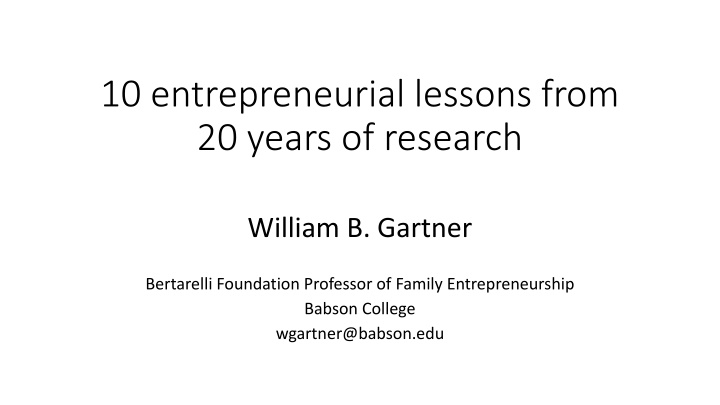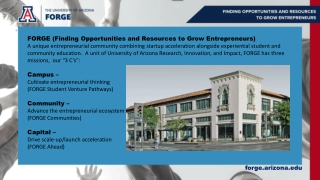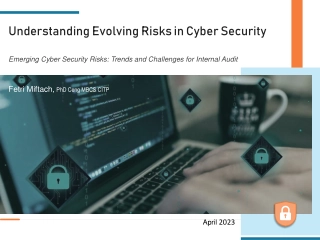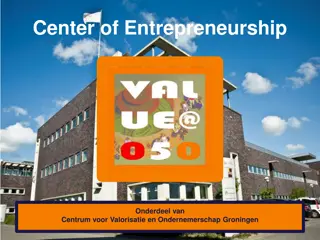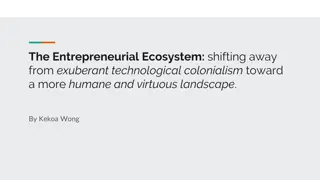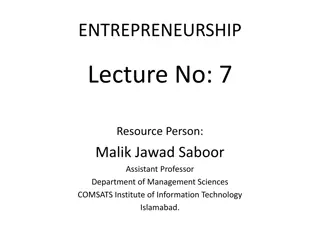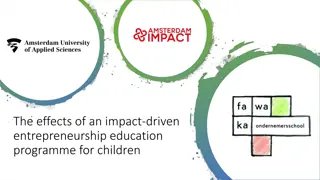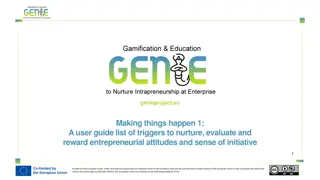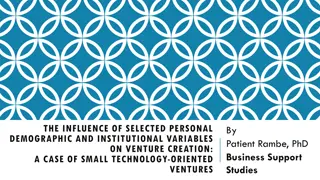Entrepreneurial Lessons from 20 Years of Research by William B. Gartner
Entrepreneurship is diverse, reflecting the future economy. Higher education and wealth correlate with entrepreneurship. Explore these insights in detail from the research of William B. Gartner.
Download Presentation

Please find below an Image/Link to download the presentation.
The content on the website is provided AS IS for your information and personal use only. It may not be sold, licensed, or shared on other websites without obtaining consent from the author.If you encounter any issues during the download, it is possible that the publisher has removed the file from their server.
You are allowed to download the files provided on this website for personal or commercial use, subject to the condition that they are used lawfully. All files are the property of their respective owners.
The content on the website is provided AS IS for your information and personal use only. It may not be sold, licensed, or shared on other websites without obtaining consent from the author.
E N D
Presentation Transcript
10 entrepreneurial lessons from 20 years of research William B. Gartner Bertarelli Foundation Professor of Family Entrepreneurship Babson College wgartner@babson.edu
1 - Entrepreneurship is about variation* There is no one type of: entrepreneur, entrepreneurial firm, entrepreneurial environment, or entrepreneurial process. Entrepreneurship is about difference. There is no one best way in entrepreneurship. *A lesson reaffirmed: Gartner, William B. (1985). A framework for describing and classifying the phenomenon of new venture creation. Academy of Management Review, 10 (4): 696-706. Gartner, William B. (1988). Who is an entrepreneur? Is the wrong question. American Journal of Small Business, 12 (4): 11-32. Reynolds, Paul D., Carter, Nancy M., Gartner, William B., and Patricia G. Greene (2004). The prevalence of nascent entrepreneurs in the United States: Evidence from the Panel Study of Entrepreneurial Dynamics. Small Business Economics. 23: 263-284. Welter, Friederike, Baker, Ted, Audretsch, David B. & William B. Gartner (2017). Everyday entrepreneurship: A call for entrepreneurship research to embrace entrepreneurial diversity. Entrepreneurship Theory and Practice. 41 (3): 311-321.
2 - Entrepreneurship reflects the future economy The kinds of businesses that are started are in services! The post- modern economy is an information, experience (and health ) economy. The role of capital, therefore, is less about financing the manufacture and distribution of goods. Reynolds, Paul D., Carter, Nancy M., Gartner, William B., and Patricia G. Greene (2004). The prevalence of nascent entrepreneurs in the United States: Evidence from the Panel Study of Entrepreneurial Dynamics. Small Business Economics. 23: 263-284. Welter, Friederike, Baker, Ted, Audretsch, David B. & William B. Gartner (2017). Everyday entrepreneurship: A call for entrepreneurship research to embrace entrepreneurial diversity. Entrepreneurship Theory and Practice. 41 (3): 311-321.
3 - Education and Entrepreneurship Higher levels of education are correlated to higher levels of entrepreneurship Reynolds, Paul D., Carter, Nancy M., Gartner, William B., and Patricia G. Greene (2004). The prevalence of nascent entrepreneurs in the United States: Evidence from the Panel Study of Entrepreneurial Dynamics. Small Business Economics. 23: 263-284.
4 - Wealth and Entrepreneurship Higher levels of wealth are correlated to higher levels of entrepreneurship (it is easier to start a business, sustain efforts to get into business, and, grow a business if you have financial resources). But not having wealth doesn t prevent people from getting into business (there are substitutes for wealth human and social capital) Reynolds, Paul D., Carter, Nancy M., Gartner, William B., and Patricia G. Greene (2004). The prevalence of nascent entrepreneurs in the United States: Evidence from the Panel Study of Entrepreneurial Dynamics. Small Business Economics. 23: 263-284. Gartner, William B., Frid, Casey S. and John C. Alexander (2012). Financing the emerging business. Small Business Economics. 39 (3): 745-761. Frid, Casey J., Wyman, David M., Gartner, William B., & Diana M. Hechavarria (2016). Low-wealth entrepreneurs and access to external financing. International Journal of Entrepreneurial Behavior & Research. 22 (4): 1-25.
5 - Motivations Do Not Matter* The reasons entrepreneurs start businesses are the same kinds of reasons people offer for getting jobs: self-realization, financial success, innovation, independence. *A lesson reaffirmed: Gartner, William B. (1988). Who is an entrepreneur? Is the wrong question. American Journal of Small Business, 12 (4): 11-32. Carter, Nancy M., Gartner, William B., Shaver, Kelly G. and Elizabeth J. Gatewood (2003). The career reasons of nascent entrepreneurs. Journal of Business Venturing. 18 (1): 13-39.
. 6 - Risk is a matter of perspective Perceptions of whether the outcomes of entrepreneurship are more (or less) uncertain does not appear to affect whether an entrepreneur successfully starts a business (or not). Gartner, William B. and Jainwen (Jon) Liao (2012). The effects of perceptions of risk, environmental uncertainty and growth aspirations on new venture creation success. Small Business Economics. 39 (3): 703-712. Gartner, William B. and Jainwen (Jon) Liao (2012). Risk takers and taking risks. In David Bodde and Caron St. John (Eds.) Chance and Intent. London: Routledge, pp. 19-34
7 - Do More!* Getting into business is the result of action. People who get into business do more. They spend more time and effort in the process and they engage in more activities. *A lesson reaffirmed: Carter, Nancy M., Gartner, William B. and Paul D. Reynolds (1996). Exploring start-up event sequences. Journal of Business Venturing. 11 (3): 151-166. Lichtenstein, Benyamin B., Carter, Nancy M., Dooley, Kevin J. and William B. Gartner (2007). Complexity dynamics of nascent entrepreneurship. Journal of Business Venturing. 22: 236-261.
8 - Plan Entrepreneurs, for the most part, have a keen sense of what the path to success will look like even though they realize that there might be detours along the way. The Scout s Motto: BE PREPARED! Liao, Jon and William B. Gartner (2006). The effects of pre-venture plan timing and perceived environmental uncertainty on the persistence of emerging firms. Small Business Economics. 27 (1): 23-40. Gartner, William B. and Jianwen (Jon) Liao (2007). Pre-venture planning. In C. Moutray (Ed.) The Small Business Economy for Data Year 2006: Report to the President. Washington, DC: U. S. Small Business Administration Office of Advocacy, pp. 212-264. Liao, Jon and William B. Gartner (2008). The influence of pre-venture planning on new venture creation. Journal of Small Business Strategy. 18 (2): 1-21.
9 - In order to see: Increase your vocabulary The language we use to talk about entrepreneurship both constrains and enlarges how we think about what entrepreneurship is and how it actually occurs, e.g. -- opportunity, discovery, creation, design, possibility, effectuation, bricolage Gartner, William B. (2011). When words fail: An entrepreneurship glossolalia. Entrepreneurship and Regional Development. 23 (1-2): 9-21. Gartner, William B. (2010). A new path to the waterfall: A narrative on the use of entrepreneurial narrative. International Small Business Journal. 28 (1): 6-19. Gartner, William B. (2007). Entrepreneurial narrative and a science of the imagination. Journal of Business Venturing. 22 (5): 613-627. Gartner, William B., Carter, Nancy M. and Gerald E. Hills (2003). The language of opportunity. In Steyaert, C & Hjorth, D. (Eds.) New Movements in Entrepreneurship. London: Edward Elgar, pp. 103-124.
10 Creating the Future* Entrepreneurship is about creating the future. IMAGINATION is the primary requirement for engaging in this activity. *A lesson reaffirmed: Gartner, William B., Barbara J. Bird, and Jennifer Starr. (1992). Acting as if: Differentiating entrepreneurial from organizational behavior. Entrepreneurship Theory and Practice. 16 (3): 13-32. Gartner, William B. (2010). A new path to the waterfall: A narrative on the use of entrepreneurial narrative. International Small Business Journal. 28 (1): 6-19. Gartner, William B. (2007). Entrepreneurial narrative and a science of the imagination. Journal of Business Venturing. 22 (5): 613-627.
